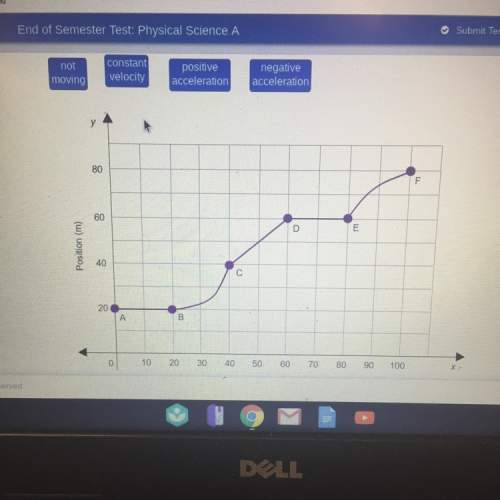
Physics, 21.01.2021 03:40 mrmendrala
PLEASE I NEED THUS THX S MUCH IT MEANS A LOT! THIS WILL KILL MY GRADE IF ITS BAD Properties of Light Lab Report Instructions: In the Properties of Light—Bending Light Lab you will explore how light rays interact as they pass from one material, or medium, to another. Record your observations in the lab report below. You will submit your completed report. Name and Title: Include your name, instructor's name, date, and name of lab. Objective(s): In your own words, what was the purpose of this lab? Hypothesis: In this section, please include the if/then statement you developed during your lab activity. This statement reflects your predicted outcome for the experiment. If I project light rays through (choose one: air, water, glass), then they will refract, or bend, the most. Procedure: Please be sure to identify the test variable (independent variable) and the outcome variable (dependent variable) for this investigation. Remember, the test variable is what is changing in this investigation. The outcome variable is what you are measuring in this investigation. Test variable (independent variable): Outcome variable (dependent variable): Select Intro to begin. Once the simulation loads, you will drag the protractor onto the screen so that the 0 lines up with the dotted line in the center of the screen. You will test all three materials in the bottom, blue half of the screen: air, water, and glass. Record your observations of how the light rays interact as they pass from air, on the top of the screen, through the three materials on the bottom of the screen Data: Record the data from each trial in the data chart below. Be sure to fill in the chart completely. Material Interactions List any observations you made as the light rays passed from the air on the top of the screen to the selected material on the bottom of the screen. Evidence Using the protractor, measure the angle as the light passes from the top material to the bottom material on the screen. Also, note the index of refraction for each as indicated on the screen. Trial One Air on top Angle: Index of refraction: Air on bottom th do much u made my day

Answers: 3
Another question on Physics

Physics, 21.06.2019 23:00
Atrain departs from its station at a constant acceleration of 5 m/s. what is the speed of the train at the end of 20s?
Answers: 1

Physics, 22.06.2019 13:00
The substances that are necessary for producing of certain hormones and that store and transport vitamins
Answers: 1


Physics, 22.06.2019 15:40
Question 1 what is amperage? is the rate of doing work. is the rate of flow of protons in electric current. represents the amount of pressure behind electron flow. is the rate of flow of electrons in electric current. 2 points question 2 what is voltage? is the rate of doing power. represents the amount of pressure behind electron flow. is the rate of doing work. is the rate of flow of electrons in electric current. 2 points question 3 what is power? is the rate of flow of protons in electric current. is the rate of flow of electrons in electric current. is the rate of doing work. represents the amount of pressure behind electron flow. 2 points question 4 if we multiply volts times amps we get what? power circuit work current 2 points question 5 what are two ways alternating currents are similiar? in both ac and dc electrons flow in the same pattern. in both ac and dc, the flow of electrons changes directions back and forth. both ac and dc are only possible in certain materials with atoms that will allow electron flow. both ac and dc involve the flow of electrons. 4 points question 6 how does the flow of electrons flow in an alternating current? the flow of electrons is always slower in an alternating current than within a direct current. the flow of electrons is not constant and forward; it changes direction back and forth. electrons flow from from a higher affinity to that of a lower affinity. electron flow is constant and only in a forward direction. 2 points question 7 what is the flow like in a direct current? the flow of electrons is not constant and forward; it changes direction back and forth. the flow of electrons is constant and only in a forward direction. the flow of electrons go from a higher affinity to a lower affinity. the flow of electrons are always faster in a direct current. 2 points question 8 how is an electric current able to flow? electrons flow from the higher affinity to lower affinity and electrical current is generated. protons flow from the higher affinity to lower affinity and electrical current is generated. the movement of protons from one atom to another leads to an electric charge. the movement of electrons from one atom to another atom in a line results in a flow of electric current. 2 points question 9 how do electrons move from the two different types of metal in a battery? protons flow from the metal with the lower affinity to the metal with higher affinity and electrical current is generated. electrons flow from the metal with the lower affinity to the metal with higher affinity and electrical current is generated. electrons flow from the metal with the higher affinity to the metal with lower affinity and electrical current is generated. protons flow from the metal with the higher affinity to the metal with lower affinity and electrical current is generated.
Answers: 2
You know the right answer?
PLEASE I NEED THUS THX S MUCH IT MEANS A LOT! THIS WILL KILL MY GRADE IF ITS BAD Properties of Light...
Questions

Arts, 25.07.2019 13:30

Biology, 25.07.2019 13:30



History, 25.07.2019 13:30


History, 25.07.2019 13:30







History, 25.07.2019 13:30









